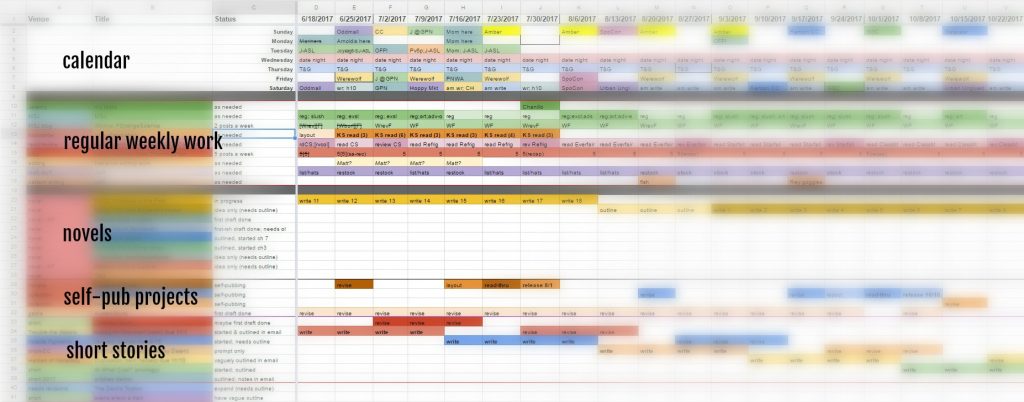My Giant Spreadsheet of Doom, Part 1

For several years now, I’ve been using a giant spreadsheet of doom to keep myself on track in terms of all of my writing projects. Because it sometimes comes up when talking with other writers, about how I keep myself organized, or how I get so much done, I thought I’d give you all a little glimpse into my organization process.
My co-worker who I share an office with has seen this spreadsheet, and she calls it a Gantt chart. This isn’t something I had heard of prior to making my spreadsheet. This was just what made sense to me in terms of keeping track of my projects!
My calendar is at the top. Each week gets a column, and each day of the week is a row. I list out the various things I have going on for the week there. This includes all sorts of stuff, some of which gets wild acronyms so that everything fits on a single line, regardless of how packed the day is. The colors all mean something too–I’m usually purple, my husband is green, and our combined things are dark blue-green. But pinkish is for date night, various shades of blue are for regularly scheduled writing things (at coffee shops), and yellows and golds are for regular gaming. Sometimes I break those color rules, if we’ve got something going on that isn’t the normal stuff. There’s an upcoming convention in a pinkish-purple color because we’re going so that I can be on panels, rather than so that we can sell books or crafts or game.
Beneath that, I have a section for the things that generally have something due for them on a weekly basis, or at least a recurring basis. For me, this is things like Mad Scientist Journal and related anthology work, posting to my blog and the MSJ blog, reviewing books for MSJ and Girl Cooties, projects for Jeremy and other potential editing work, and my craft business. When the work is done, I can strike through it, or bracket it if only part of it is done. I use a lot of abbreviations here, too, again to keep each row as a single line. (I adjust column widths occasionally, but I try to keep them pretty small so I can see a lot of columns at the same time.)
Then we get into the non-regular writing projects. The next section down is for the novels I’ve got planned. (How many? Too many. This spreadsheet currently goes into 2021 …) These get rearranged a lot, depending on what I think I want to work on next. At the moment, I’m chugging along on a trilogy, so I’ve got those at the top, and I won’t get a chance to work on other things until later. This section includes both writing (first drafts) and editing (subsequent drafts), though only the writing portions are showing right now.
The next section is for my self-publishing projects–mostly short story collections or novellas, but also a game that we’re working on. These are usually tightly compact little sections, as I’ve normally done the vast majority of the writing and editing work on these before they reach this stage. The game is the exception to this, because we recently decided to give it a major rewrite. So there’s a whole lot of “revise” for that.
Finally, the bottom section is for short stories. There are a lot more rows beneath what you can see. A lot of those rows say “TBD,” because I don’t know what short stories I might want to write next year … though I do have some already figured out down the road.
For those final three sections, when I’ve finished a project, I pull the whole row. Depending on what the project was, it typically gets recorded on a different sheet in the spreadsheet (which is something to explain another day). So I can look at my spreadsheet at any given time to see the projects that I’m working on and where I’ve got projects coming up. When I get a new idea, I make a new row or fill in a TBD row.
Next Monday, I’ll talk about the columns and how I plan out what I’ll be working on each week! Check back then for more on the giant spreadsheet of doom!

Comments